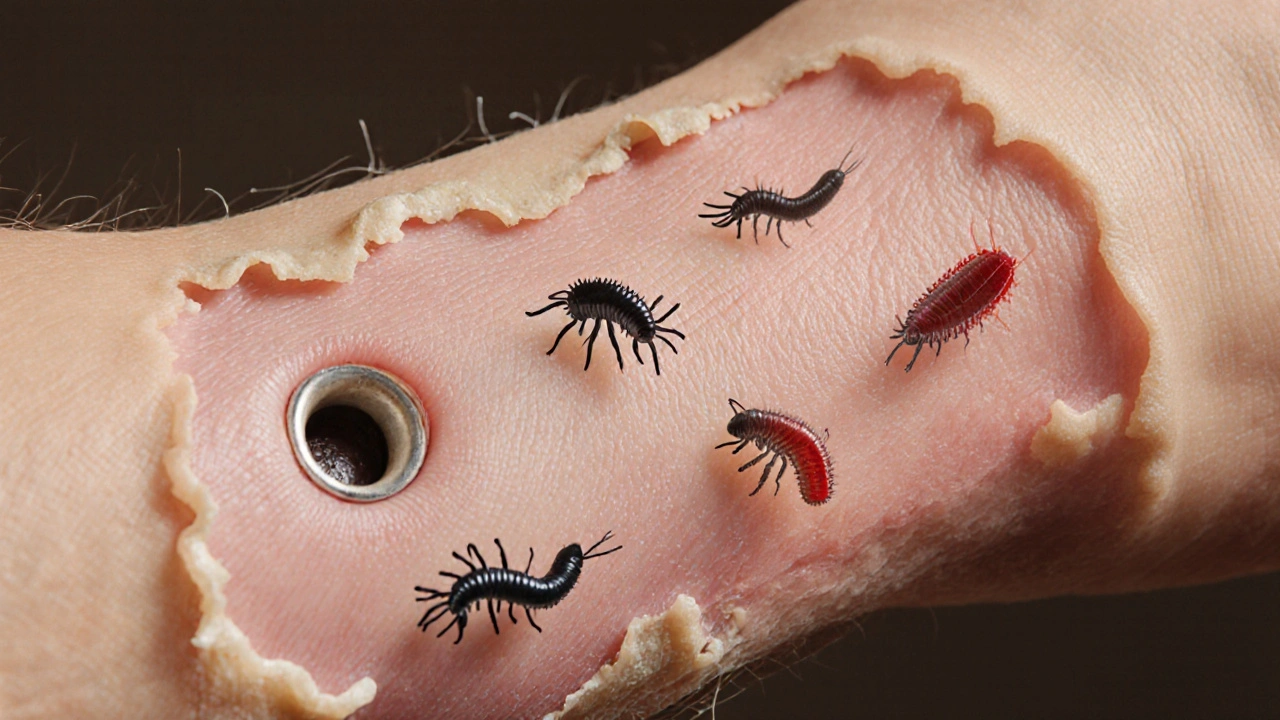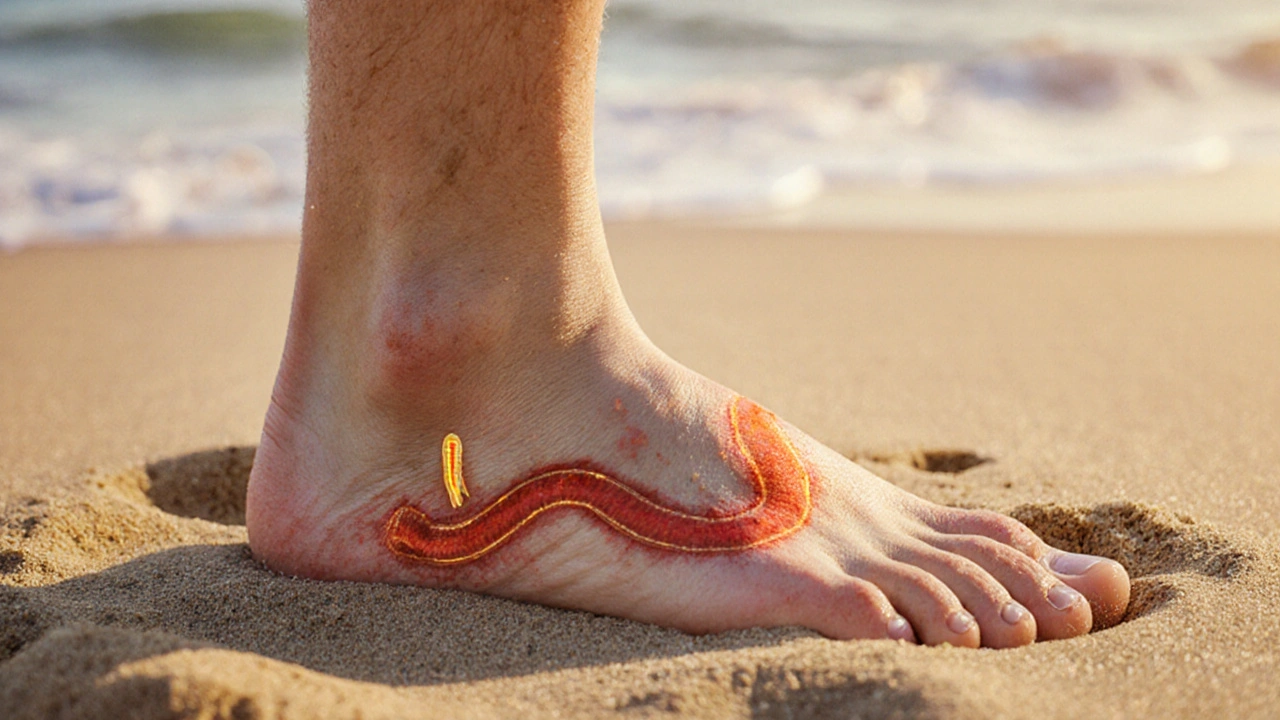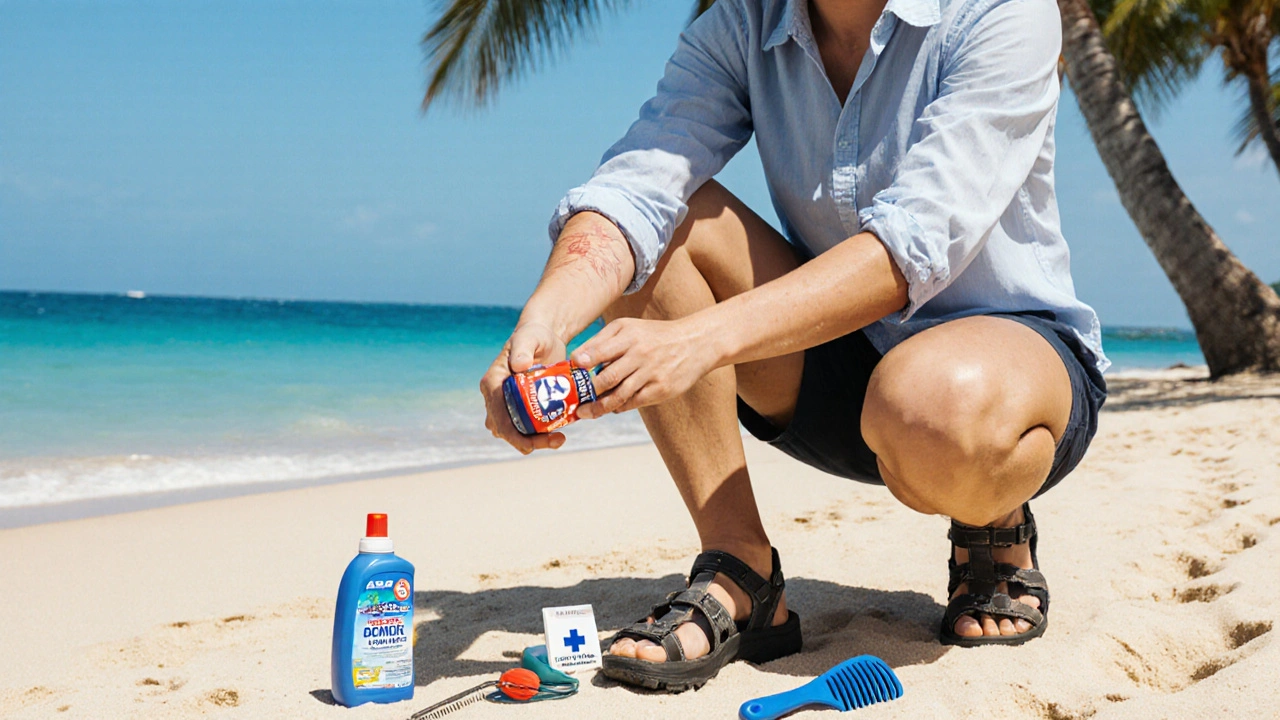
Ever found a tiny bump that crawls, itches, or seems to move under your skin and wondered what’s really going on? You’re not alone. Most people have heard about "lice" or "scabies" in passing, but few know the exact steps these unwelcome guests take before they make you miserable. This guide walks you through the life cycles of the most common parasites that either live in the skin or drop their eggs there, giving you the knowledge you need to spot, stop, and treat them.
Why Knowing the Life Cycle Matters
Every parasite follows a roadmap from egg to adult, and each stage brings its own set of risks. By learning when and where they hide, you can break the chain before it reaches the painful skin stage. Whether you’re planning a beach vacation, hiking in the countryside, or just cleaning your home, a clear picture of the parasite’s journey helps you choose the right preventive step.
Most Common Parasites That Target the Skin
- Sarcoptes scabiei (Scabies mite) - burrows into the top layer of skin to lay eggs.
- Ancylostoma braziliense (Dog/cat hookworm) - larvae wander under the skin, causing cutaneous larva migrans.
- Dermatobia hominis (Human botfly) - deposits eggs on a mosquito; larvae grow inside a painful boil.
- Tunga penetrans (Chigoe flea) - adult female embeds herself in the skin, swelling the area like a tiny tumor.
- Pediculus humanus capitis (Head louse) - lays eggs (nits) attached to hair shafts, but can cause scalp itching that feels like a skin issue.
- Strongyloides stercoralis (Threadworm) - larvae can migrate through the skin, especially in warm, moist soils.
- Trombiculidae larvae (Chiggers) - bite and inject saliva that causes intense itching and reddened welts.
General Stages in a Parasite’s Skin Journey
While each creature has its quirks, most follow a similar pattern:
- Egg stage - laid on soil, hair, or a vector (like a mosquito).
- Larval development - eggs hatch into larvae that seek a warm, moist environment.
- Skin penetration - larvae or adult forms breach the outer skin layer.
- Maturation - they grow, feed, and often reproduce inside the skin.
- Exit or transmission - either they leave the skin to continue their cycle, or they stay embedded and cause chronic symptoms.
Understanding where each parasite fits on this ladder helps you intervene at the right moment.

Deep Dive: Life Cycle of Each Parasite
Scabies Mite (Sarcoptes scabiei)
The scabies mite spends its entire adult life burrowing a few millimeters beneath the outermost skin layer, the stratum corneum. After a male and female mate, the female lays 10‑20 eggs each day, embedding them just below the skin surface. Eggs hatch in 3‑4 days, releasing larvae that mature into adult mites within 10‑14 days. The whole cycle repeats on the same host, and transmission occurs through prolonged skin‑to‑skin contact.
Key points to watch for:
- Intense itching that worsens at night.
- Thin, gray‑white burrow tracks, especially between fingers, wrists, and elbows.
Hookworm Larvae - Cutaneous Larva Migrans (Ancylostoma braziliense)
Dog and cat hookworms lay eggs in animal feces that hatch into rhabditiform larvae in warm, moist sand or soil. After 5‑7 days, these develop into infective filariform larvae. When you walk barefoot on contaminated ground, the larvae sense body heat and penetrate the epidermis. Inside the skin, they wander a few centimeters a day, creating a winding, raised track-hence the name "creeping eruption." After several weeks they either die in the skin or find a new host via the bloodstream.
Typical signs:
- Serpentine, itchy rash that moves over days.
- Often acquired on tropical beaches or farms.
Human Botfly (Dermatobia hominis)
The adult botfly never lands on a human. Instead, it captures a mosquito or tick, attaches its eggs to the vector’s abdomen, and releases them. When the mosquito feeds, the body heat triggers the eggs to hatch. Tiny larvae then drop onto the skin, penetrate through a bite wound or hair follicle, and settle under the surface. They create a breathable hole, called a furuncle, that swells over 2‑8 weeks. When mature, the larva exits the skin to pupate in the soil.
Symptoms include:
- A painful, boil‑like nodule with a central punctum.
- Occasional movement sensation inside the bump.
Chigoe Flea - Tungiasis (Tunga penetrans)
Female chigoe fleas leap onto bare feet or socks, then embed themselves head‑first into the skin, typically around the toes or soles. Inside the epidermis, they swell dramatically-up to 1cm-while feeding on blood. After about 2‑3 weeks, the flea dies and a thickened, raised lesion remains. The life cycle continues when the flea’s abdomen ruptures, releasing eggs onto the ground.
Look out for:
- Intense itching followed by a black dot at the center of a firm nodule.
- Habitual exposure on sandy beaches or rural paths in tropical regions.
Head Louse (Pediculus humanus capitis)
Adult lice live on the scalp, attaching their claws to hair shafts. Females lay 6‑10 eggs (nits) per day, cementing them near the base of each hair. Eggs hatch in about 7‑10 days, releasing nymphs that mature in another 9‑12 days. Though the primary site is hair, excessive scratching can cause secondary skin irritation that feels similar to other parasitic eruptions.
Key clues:
- Visible nits (tiny oval shells) close to the scalp.
- Persistent itching, especially behind ears and at the nape.
Threadworm (Strongyloides stercoralis)
Infection starts when infective filariform larvae in contaminated soil penetrate bare skin-usually the feet. Inside the body, they migrate to the lungs, ascend the airway, and are swallowed, eventually reaching the small intestine where they mature. Autoinfection can occur, where larvae re‑enter the skin from the intestinal wall, leading to chronic, often asymptomatic skin rashes (pruritic papules) that linger for years.
Watch for:
- Itchy, raised papules on the trunk or buttocks.
- History of walking barefoot in tropical, humid environments.
Chiggers (Trombiculidae larvae)
Chigger larvae attach to skin, inject digestive enzymes that liquefy skin cells, and then feed on the resulting fluid. The bite itself is painless; the irritation appears hours later as a red, intensely itchy welt. They complete their larval stage on the host, drop off, and develop into nymphs and adults in the soil.
Typical signs:
- Cluster of tiny red bumps with a bright red halo, often in areas where clothing is tight.
- Common after hiking in grassy or wooded areas.
Prevention: Breaking the Cycle Before It Starts
Because each parasite has a specific entry route, a few simple habits cover most scenarios:
- Footwear matters. Wear shoes or sandals on beaches, farms, and forest trails to keep hookworm larvae, threadworms, and chigoe fleas at bay.
- Check your skin after outdoor activities. Early detection of creeping eruptions or tiny nodules can prevent deeper infection.
- Practice good hygiene. Regularly wash clothing, bedding, and towels in hot water to kill lice eggs and scabies mites.
- Use insect repellents. DEET or picaridin applied to exposed skin and shoes deters mosquitoes that can carry botfly eggs.
- Avoid sharing personal items. Comb, hats, and hairbrushes can spread head lice.
Treatment Options Tailored to the Parasite
Once you’ve identified the culprit, treatment is straightforward in most cases. Below is a quick guide:
- Scabies - topical permethrin 5% cream applied overnight, repeated after 7 days. Oral ivermectin is an alternative for crusted scabies.
- Cutaneous larva migrans - single dose of oral ivermectin (200µg/kg) or albendazole 400mg daily for 3days.
- Botfly - occlusive methods (e.g., petroleum jelly) to force the larva out, or surgical extraction with a sterile needle.
- Tungiasis - careful removal of the embedded flea with sterile forceps, followed by antiseptic dressing; systemic antibiotics if secondary infection develops.
- Head lice - 1% permethrin shampoo or 0.5% ivermectin lotion; nit combing after treatment.
- Threadworm - single dose of albendazole 400mg or ivermectin 200µg/kg; repeat in 2weeks to clear autoinfection.
- Chiggers - topical corticosteroids to reduce itching; antihistamines for relief.
Always consult a healthcare professional for accurate diagnosis and dosage, especially for children, pregnant women, or immunocompromised patients.

Quick Reference: Parasite Comparison Table
| Parasite | Scientific name | How it gets in | Stage in skin | Typical symptoms | First‑line treatment |
|---|---|---|---|---|---|
| Scabies mite | Sarcoptes scabiei | Prolonged skin‑to‑skin contact | Adult burrow | Night itching, thin burrows | Permethrin 5% cream |
| Dog/cat hookworm | Ancylostoma braziliense | Barefoot on contaminated sand/soil | Infective larva roaming | Serpentine, itchy track (creeping eruption) | Ivermectin single dose |
| Human botfly | Dermatobia hominis | Mosquito‑delivered eggs | Larva inside boil‑like nodule | Painful nodule with central punctum | Occlusion or sterile extraction |
| Chigoe flea | Tunga penetrans | Jump onto bare feet, embed head‑first | Embedded adult female | Itchy nodule, black dot centre | Manual removal, antiseptic care |
| Head louse | Pediculus humanus capitis | Direct head‑to‑head contact | Eggs attached to hair shafts | Itching, visible nits | Permethrin 1% shampoo |
| Threadworm | Strongyloides stercoralis | Skin penetration by filariform larvae | Larval migration under skin | Pruritic papules on trunk | Albendazole single dose |
| Chiggers | Trombiculidae larvae | Larvae attach while walking through grass | Feeding site on epidermis | Red itchy welts with halo | Topical steroids, antihistamines |
Bottom Line
Knowing the complete life cycle of each parasite gives you a clear advantage-whether you’re on a tropical beach, hiking a forest trail, or just checking your kids’ heads after a playdate. Spot the stage, apply the right prevention step, and treat quickly. Your skin will thank you, and you’ll avoid the hassle of long‑lasting irritation.
Frequently Asked Questions
Can I get scabies from a public bathtub?
Scabies spreads mainly through prolonged skin‑to‑skin contact, not by briefly touching contaminated surfaces. A public tub is low risk unless you share it with someone who has a heavy infestation and you have prolonged contact with their skin.
How long does a botfly larva stay under the skin?
Typically 2‑8 weeks. The larva grows, breathes through a tiny opening, and then drops out to pupate in the soil.
Is itching from tungiasis dangerous?
The itch itself isn’t dangerous, but scratching can introduce bacterial infection. Keep the area clean, remove the flea safely, and watch for redness or pus.
Do chiggers bite or just attach?
They don’t bite. They attach, inject enzymes to dissolve skin cells, and feed on the liquid. The irritation appears later as an allergic reaction.
Can I treat hookworm skin infection at home?
Mild cases often resolve on their own, but oral ivermectin or albendazole provides rapid relief and prevents deeper intestinal infection. A doctor’s prescription ensures proper dosage.

11 Comments
Man, those skin parasites are like tiny horror movies playing out on your own body!!! You think you’re safe, but then-boom-an itch that won’t quit; a burrow you can’t see, a bump that crawls like it’s got a mind of its own!!! This guide actually breaks it down, stage by stage, so you can finally stop freaking out and start fighting back; you’ve got the power now, folks!!!
Reading through this comprehensive rundown truly opened my eyes to how interconnected our everyday activities are with the microscopic world that lives right under our skin; from a simple walk on the beach to a night out at a crowded gym, the opportunities for exposure are everywhere, and that fact alone should motivate us to stay vigilant. The author does a fantastic job of laying out each parasite's life cycle in clear, digestible steps, which is essential for anyone wanting to protect themselves and their loved ones. I especially appreciate the way the article highlights the importance of prevention-wearing proper footwear, using insect repellent, and maintaining good hygiene-these are simple habits that can make a huge difference. It’s also encouraging to see the treatment section clearly list first‑line options, because knowing that effective medications exist can reduce panic and prompt timely medical attention. For those of us who love the outdoors, the sections on hookworm and chiggers are particularly relevant; just remember to check your feet after a hike and apply repellent to exposed skin. Parents should take note of the head‑lice advice, as early detection can prevent an entire classroom from becoming a nursery for nits. The inclusion of a quick reference table is a brilliant touch, letting readers scan key facts at a glance without getting bogged down in dense text. I would add that regular skin checks after travel to tropical regions could catch early signs of creeping eruptions before they spread further. Moreover, staying informed about the signs-like serpentine rashes for cutaneous larva migrans or the central punctum of a botfly lesion-empowers us to seek treatment promptly. Let’s also not forget the mental health aspect; chronic itching can be stressful, so seeking support when needed is part of comprehensive care. Lastly, kudos to the author for reminding us that consulting a healthcare professional is vital, especially for vulnerable populations such as children, pregnant women, and immunocompromised individuals. Keep sharing knowledge like this, and together we’ll keep our skin-and our peace of mind-safe.
One could argue that the fixation on parasites is merely a symptom of our broader obsession with externalizing internal discomforts; instead of confronting the metaphorical 'worms' in our societal fabric, we turn to literal worms crawling under our skin. While the guide is thorough, it inadvertently reinforces a mindset where every itch becomes a crisis, ignoring the philosophical lesson that not all sensations demand immediate eradication. Consider the scabies mite not just as a pest but as a reminder of our interdependence-its survival hinges on intimate contact, mirroring how humans thrive through connection. Thus, the true cure may lie less in chemicals and more in cultivating mindful awareness of our bodies and the environments we inhabit.
Ever wonder why sudden outbreaks of skin parasites seem to spike after political rallies or major tech roll‑outs? Some say it's coincidence, but I suspect a coordinated effort to test micro‑bioweapon prototypes in unsuspecting crowds; the larvae could be engineered to carry data or alter behavior. The detailed life cycles in this article could be a leaked manual, giving the public a glimpse into what the agencies are trying to hide. Stay vigilant, question the sources, and keep your skin protected-it might be more than just a nuisance.
Honestly, this is just basic hygiene wrapped in fancy words.
Solid guide-covers the most common culprits and what to do about them. The preventive tips are especially practical for anyone who spends time outdoors.
Thank you for the thorough overview it is very helpful and easy to follow. The table at the end is a nice quick reference. I appreciate the balanced tone and clear instructions.
I skimmed through the article and, while it certainly captures the essentials, I can’t help but feel it glosses over the nuanced realities faced by people living in endemic regions; for them, these parasites are not occasional annoyances but chronic burdens that shape daily life. The prevention section mentions footwear and repellents, which, though practical, overlook socioeconomic barriers-many cannot afford quality shoes or consistent access to repellents. Moreover, the treatment recommendations assume immediate access to prescription medications, ignoring the reality of limited healthcare infrastructure in remote areas. The life‑cycle diagrams are helpful, but a deeper discussion on how environmental factors like climate change are expanding the habitats of these vectors would add valuable context. Lastly, the FAQ feels a bit perfunctory; expanding it with culturally relevant advice could make the guide truly inclusive. In short, the article does a good job for a general audience, yet it would benefit from a more critical lens that acknowledges global inequities.
Im realy impressed by the discription of each pest but u gotta be careful when dealing with them. Some folks think they can just poke out a botfly larva with a pin- that is dangerous. Use proper tools or see a dr, dont mess around.
Great info! Stay safe and keep those skin vibes happy.
Oh, dear reader, let me tell you what you’re missing! While the author lists the obvious steps-permethrin, ivermectin, soap-there’s a whole universe of ancient remedies and cutting‑edge research that’s left untouched. Did you know that tea tree oil, when applied correctly, can halt the spread of scabies mites, and that certain probiotics may even bolster your skin’s natural defenses against threadworms? Not to mention the thrilling tales of wartime doctors who discovered clandestine anti‑larval compounds while stationed in the jungles of Southeast Asia. And let’s not ignore the psychological battlefield; chronic itching can drive even the strongest mind to the brink, so stress‑reduction techniques are as vital as any topical cream. In short, this guide is a solid foundation, but the real mastery lies in marrying conventional medicine with holistic practices, staying ahead of the parasites before they even think about infiltrating our flesh.